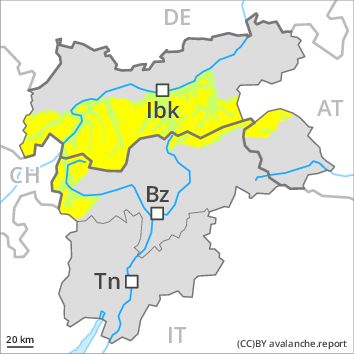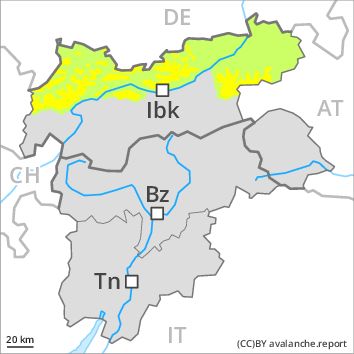Regions
Weißkugel Range, Val Müstair Alps, Western Verwall Mountains, Gurgler Range, Langtaufers, Eastern Verwall Mountains, Central Stubai Alps, Ortler Range, Silvretta, Northern Zillertal Alps, Samnaun Mountains, Venediger Range, Southern Zillertal Alps and High Tauern, Northern Oetz and Stubai Alps, Western Tuxer Alps, Eastern Tuxer Alps, Glockturm Range

Danger level
Danger Level 2 - Moderate above 2400m
Danger Level 1 - Low above 2400m
Avalanche Problem
Wind-drifted snow above 2400m, N-NE-E-W-NW
Gliding snow above 2000m, E-SE-S-SW-W

Wind slabs at high altitudes and in high Alpine regions.
The clearly visible wind slabs of the last few days must be evaluated with care and prudence in particular on northwest to north to northeast facing aspects above approximately 2400 m. They can be released, especially by large additional loads,. Especially adjacent to ridgelines avalanches can be triggered in deep layers of the snowpack and reach medium size in isolated cases. Apart from the danger of being buried, restraint should be exercised in view of the danger of avalanches sweeping people along and giving rise to falls. As a consequence of warming, the likelihood of gliding avalanches being released will increase gradually in particular below approximately 2000 m.
Snowpack
dp 6: cold, loose snow and wind
Faceted weak layers exist in the snowpack especially above approximately 2400 m. In addition the rather small wind slabs of the last few days in particular adjacent to ridgelines and in gullies and bowls and generally in the high Alpine regions are prone to triggering in some cases still. The snowpack will be subject to considerable local variations.
Tendency
Decrease in danger of dry avalanches. Gliding avalanches are possible.
Regions
Karwendel Mountains, Brandenberg Alps, Western Kitzbühel Alps, Wilder Kaiser Mountains - Waidring Alps, Eastern Kitzbühel Alps, Western Lechtal Alps, Central Lechtal Alps, Grieskogel Mountains, Allgäu Alps, Eastern Lechtal Alps - Ammergau Alps, Mieming Mountains

Danger level
Danger Level 2 - Moderate above 2400m
Danger Level 1 - Low above 2400m
Avalanche Problem
Wind-drifted snow above 2400m, N-NE-NW
Gliding snow above 2000m, E-SE-S-SW-W

Wind slabs above approximately 2400 m.
The clearly visible wind slabs of the last few days must be evaluated with care and prudence in particular on northwest to north to northeast facing aspects above the tree line. They can be released in isolated cases, but mostly only by large additional loads, above approximately 2400 m. Adjacent to ridgelines avalanches can be triggered in deep layers of the snowpack and reach medium size in some cases. Apart from the danger of being buried, restraint should be exercised in view of the danger of avalanches sweeping people along and giving rise to falls. As a consequence of warming, the likelihood of gliding avalanches being released will increase gradually in particular below approximately 2000 m.
Snowpack
dp 6: cold, loose snow and wind
Faceted weak layers exist in the snowpack especially above approximately 2400 m. In addition the rather small wind slabs of the last few days in particular adjacent to ridgelines and in gullies and bowls and generally in the high Alpine regions are prone to triggering in some cases still. The snowpack will be subject to considerable local variations.
Tendency
Decrease in danger of dry avalanches. Gliding avalanches are possible.
Regions
Sexten Dolomites, Latemar, Schnals Ridge, Southern Stubai Alps, Saldurn-Mastaun Ridge, Texel Mountains, Southern Adamello, Sarntal Alps, Adamello - Presanella, Western Pfunderer Mountains, Northern Brenta - Peller, Bondone and Stivo, Folgaria - Laverone, Southern Brenta, Southern Lagorai, Northern Lagorai, Maddalene, Pine' - Mocheni Valley, Eastern Pfunderer Mountains, Durreck Range, Western Rieserferner Mountains, Western Deferegger Alps, Ulten Valley, Eastern Nonsberger Alps, Eastern Rieserferner Mountains, Northern Dolomites of Fiemme, Glockner Range, Gröden Dolomites, Primiero - Pale di S. Martino, Eastern Deferegger Alps, Prags Dolomites, Prealps, Schober Mountains, Cembra Valley, Lienzer Dolomites, Vallarsa, Western Nonsberg Alps, Fassa Valley, Sole, Pejo and Rabbi, Ledro Valley, Paganella, Marzola - Valsugana

Danger level
Danger Level 1 - Low
Avalanche Problem
Wind-drifted snow above 2400m, N-NE-NW

The backcountry touring conditions are generally favourable. Wind slabs require caution.
The somewhat older wind slabs are to be avoided in particular in extreme terrain. Mostly avalanches are only small and can be released by large loads. At high altitudes and in high Alpine regions avalanche prone locations are a little more prevalent. Adjacent to ridgelines avalanches can be triggered in deep layers of the snowpack and reach medium size in some cases. Apart from the danger of being buried, restraint should be exercised in view of the danger of avalanches sweeping people along and giving rise to falls. In steep terrain there is a danger of falling on the hard snow surface.
Snowpack
dp 6: cold, loose snow and wind
In particular shady slopes where hard layers are lying on a weakly bonded old snowpack are unfavourable. Such avalanche prone locations are rather rare but are barely recognisable, even to the trained eye. The snowpack will be subject to considerable local variations.
Tendency
Wind slabs are to be evaluated with care and prudence. The conditions are favourable over a wide area for snow sport activities outside marked and open pistes.



